
With more people shopping online than ever before, ecommerce is one of the fastest-growing industries in the world.
Whether you’re looking to start a new retail venture or bring your current retail business into the digital age, it’s important to have a good understanding of the ecommerce industry.
In this article, we’ll be taking a look at the latest ecommerce statistics, facts, and trends you need to know.
Ready? Let’s get started.
General ecommerce statistics
Ecommerce really is a big deal in today’s world. Whether you’re a business owner or a marketer, it’s important to have some knowledge of the ecommerce industry. Here are some general ecommerce statistics that can help bring you up to speed.
1. Global ecommerce sales are expected to reach $4.89 billion in 2021
The last couple of years have been remarkable for ecommerce businesses. With more people buying online than ever before, it’s no surprise that global ecommerce sales are expected to reach almost $5 billion this year.
According to Statista, ecommerce revenue for 2020 reached over $4.2 billion and is expected to reach $4.89 billion this year. By 2024, yearly global ecommerce sales are expected to exceed $6 billion.
Source: Statista1
2. There is currently between 12 and 24 million online stores
With new stores emerging every day, it can be hard to pin down exactly how many ecommerce stores there are in total.
However, according to estimations made by Digital in the Round, there could be as many as 24 million. However, they also stated that there could be closer to 12 million, so it’s difficult to put a figure on it. But what we can say for sure is that there is a LOT.
Source: Digital in the Round
3. In the US there are approximately 263 million online shoppers
With so many ecommerce stores available, it’s no surprise that there is a shockingly high percentage of the world’s population that choose to shop online.
According to Digital in the round, there are at least 263 million online shoppers in the US alone. This number has grown substantially over the last couple of years, with more people opting to shop online instead of visiting brick-and-mortar stores.
Source: Digital in the Round
4. The average consumer completes 19 online transactions per year
As we can see from the last statistics, people love to shop online, and the average online shopper makes purchases pretty frequently.
Globally, online shoppers make on average 19 transactions per year. The popularity of online shopping varies around the world.
For example, figures show that online shopping is particularly popular in China, where the average shopper completes around 22 online transactions each year.
Source: Digital in the Round
5. Amazon is the leading consumer internet and online services company worldwide
When you think of ecommerce, you most likely think of Amazon. Amazon is for sure the most well-known ecommerce marketplace. In fact, it’s officially the leading consumer internet and online services company worldwide based on revenue.
According to Statista, Amazon is worth just over $1.7 trillion as of June 2021. The only other company that comes close to Amazon is Chinese ecommerce titan Alibaba, which is thought to be worth 614 billion as of June 2021.
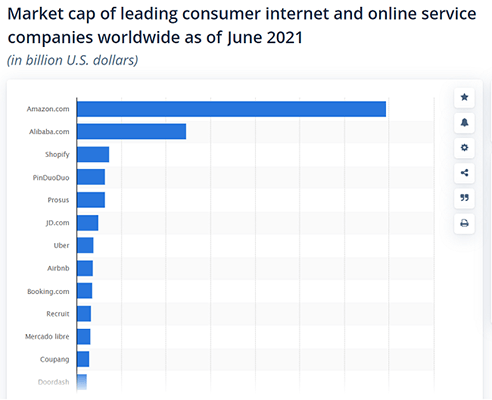
Source: Statista2
6. And it was the most visited online retail website in the world
In addition to being the highest-grossing online services company, Amazon is also the most visited online retail store in the world. In 2020 alone, Amazon recorded over 3.6 billion visitors to their site.
The second most visited online retail store is the popular new and used goods marketplace eBay, which saw just over 1 billion visitors in 2020. Other popular ecommerce sites include the Japanese marketplace Rakuten and the South Korean conglomerate Samsung.
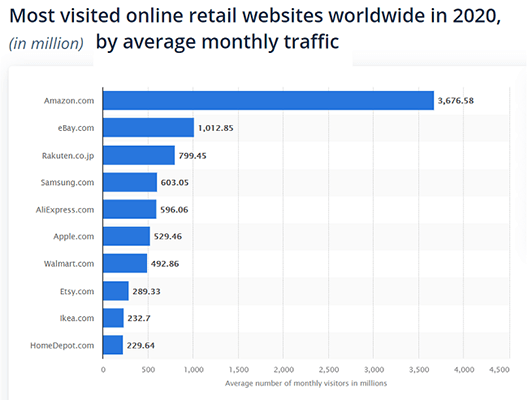
Source: Statista3
7. Ecommerce sales make up for 10-11% of all US retail sales
Although brick-and-mortar stores are still the norm for most people, ecommerce is becoming a more prominent part of everyday life.
According to Digital in the Round, around 11% of all retail sales in the US are made online via ecommerce stores. This figure is evidence of the fact that people still like to shop physically rather than digitally. However, external factors such as the pandemic are encouraging more people to shop online.
Source: Digital in the Round
8. The Chinese market made up for 33% of global ecommerce sales in 2020
One country that is excelling in the ecommerce space is China. Around a third of global ecommerce sales come from China, and many popular ecommerce marketplaces such as Alibaba and TaoBao are based there.
According to statistics published by eMarketer, the Chinese ecommerce market generated just over $790 million in sales last year.
Source: eMarketer
9. Food and beverage is the highest converting ecommerce vertical, with average conversion rates of 5.5%
If you’re thinking about starting an ecommerce business, you may want to consider selling food and beverages. According to Statista, the Food and Beverage industry is the highest converting ecommerce vertical.
Businesses in this niche have an average conversion rate of 5.5%. Other high converting verticals include hair care, beauty and skincare, and health and beauty. The lowest converting verticals are luxury handbags and home furniture, which have average conversion rates of 0.6%
Source: Statista4
10. Approximately 1.94% of ecommerce store visits result in a sale
Overall though, ecommerce stores are pretty good for turning visits into sales. According to Oberlo, around 1.94% of all visits to ecommerce sites result in a sale. This is a great conversion rate, and good news if you’re looking to start an ecommerce business in 2021.
Source: Oberlo
Ecommerce platform statistics
When it comes to running an ecommerce business, there are many different routes you can take, and different platforms to choose from. Here are some interesting statistics relating to the most well-known ecommerce platforms.
11. Shopify is the most popular ecommerce platform, with a 26% market share
If you’re thinking about building an ecommerce store, you’ll need to choose an ecommerce platform that can help you to manage payments and other aspects of your site. The most popular option available is Shopify.
According to TrustRadius, Shopify has around a 26% market share, making it the most used ecommerce solution. Shopify can be used to build and optimize your site for ecommerce sales and manage all of the day-to-day tasks. Therefore, it’s no surprise that it’s the first choice for many ecommerce businesses.
Source: TrustRadius
12. 1.7 million ecommerce sites are powered by Shopify
Shopify is well known as a platform that allows just about anyone to start their own ecommerce business. Whether you’re a seasoned ecommerce entrepreneur or a first-timer, Shopify provides everything you need to get started.
According to their about page, around 1.7 million stores use Shopify, and all of these have made at least $200 selling goods online. Shopify is also used in over 170 countries worldwide.
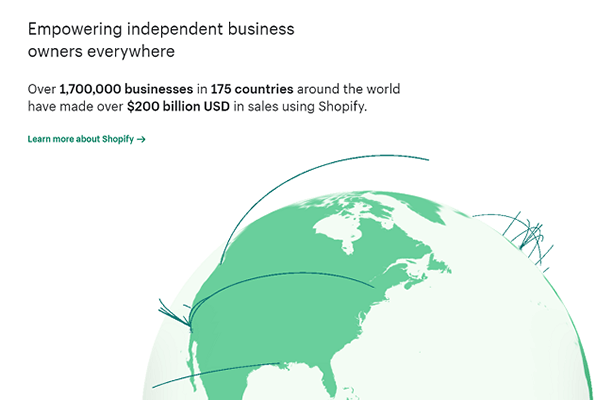
Source: Shopify
13. WooCommerce has over 5 million downloads
The second most used ecommerce platform is WooCommerce. WooCommerce is an ecommerce plugin that can be used in conjunction with WordPress sites to create functional and high-converting online stores.
WooCommerce is an extremely popular ecommerce solution, and according to the WordPress plugin directory, it’s been downloaded more than 5 million times to date. According to TrustRadius, Woocommerce has around a 12% share of the ecommerce software market.

Source: WordPress
14. Salesforce, BigCommerce, and Wix each command a 12% share of the ecommerce software market
Although Shopify and WooCommerce are well-known names in the ecommerce industry, there are many alternatives that are also extremely popular. Some of the most popular ecommerce platforms include Wix, Salesforce Commerce Cloud, and BigCommerce.
Each of these companies commands a 12% share of the overall ecommerce platform market. Each ecommerce platform has its own set of tools and unique selling points, so it’s well worth looking into the different options available before choosing the platform that’s right for your business.
Source: TrustRadius
15. Squarespace has a 9% share of the ecommerce software market
Squarespace is a popular website building tool that also has ecommerce functions. Despite being better known as a place where beginners can easily build a website, Squarespace is fast becoming a player in the ecommerce software market.
At present, it commands a 9% share of the market and is becoming more and more popular with businesses looking for an easy-to-use platform with ecommerce functions like payment portals.
Source: TrustRadius
16. Up and coming ecommerce platform Flipkart secured $3.6 Billion in funding this year
As the ecommerce industry continues to grow, more and more tools and platforms are emerging to meet the needs of businesses. One up-and-coming ecommerce platform that looks set to break into the market is Flipkart.
This India-based ecommerce platform reportedly secured $3.6 billion in funding for development. This huge investment is a positive sign and could help Flipkart become one of the big players in the ecommerce software industry.
Source: BBC
Ecommerce consumer statistics
Keen to learn more about how consumers interact with ecommerce businesses? Here are some key facts and statistics relating to ecommerce consumers.
17. There are over 2.14 billion digital buyers worldwide
According to Statista, over 2 billion people across the world are digital buyers. This accounts for just under half of all internet users globally. This figure has increased by almost 1 billion since 2014, and the steady adoption of ecommerce is set to continue in years to come.
Source: Statista5
18. 52% of shoppers look for purchase inspiration on Amazon
This is a key statistic for new businesses looking to build up an online customer base. Although there are many ecommerce stores making sales through their own website, Statista found that over half of all online shoppers start their buyer journey by searching for products on Amazon.
For this reason, many ecommerce sellers operate solely through Amazon or at least maintain a presence on Amazon to direct traffic to their own websites or products.
Source: Statista6
19. 70% of consumers read between 1 and 6 reviews before making an online purchase
Online shoppers are notoriously savvy, and they use every means at their disposal to ensure that they’re making smart purchasing decisions.
One way buyers judge the authenticity and reliability of products is via online reviews. The average online shopper checks up to six buyer reviews before making a purchase.
Therefore, it’s extremely important for ecommerce stores to encourage their customers to leave product reviews, and to ensure that those reviews are consistently positive.
Source: Statista7
20. 45% of e-commerce transactions were made from digital or mobile wallets in 2020
One reason that online shopping is becoming more popular is that it’s now easier than ever to pay for products online.
With the rise of mobile and digital wallets like Apple Pay and PayPal, customers can pay for products quickly and securely without having to input reams and reams of payment details. According to Statista, just under half of all ecommerce transactions were made from digital and mobile wallets last year.
Source: Statista8
21. 81% of buyers do online research before making purchases
In addition to listing products for sale, it’s important for online sellers to make information about their products available across the web.
In 2021, the average online shopper is extremely skilled at conducting internet research, and therefore it’s important that they can find detailed and useful information about the products they’re interested in.
In fact, CSA found that around 81% of shoppers conduct online research online before making a purchase, which is why many ecommerce stores invest in blogs and knowledge base content to help internet users learn more about their products.
Source: CSA
22. Almost 60% of all online shopping carts are abandoned…
One of the main issues that ecommerce stores face when it comes to consumers is shopping cart abandonment. It’s commonplace for shoppers to choose their products and fill their carts, and then fail to complete their purchase.
On average, around 60% of all digital shopping carts are abandoned in this way, and this presents a huge challenge for businesses owners.
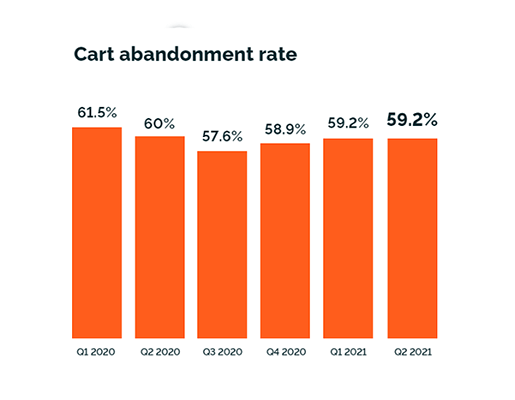
Source: Fresh Relevance
23. …and 49% of consumers say this is a result of high extra costs at checkout
In order to reduce cart abandonment rates, sellers need to identify what it is that is making their customers leave the site before making a purchase.
A study by Baymard found that the main reason shoppers abandon their carts is ‘high extra costs at checkout’. This includes costs like shipping fees, packaging fees, or any other hidden costs that aren’t shown on the product page.
Other common reasons for cart abandonment include mandatory account creation and slow delivery timescales.

Source: Baymard
24. 20.2% of digital buyers are aged between 25 and 34
According to a statistic published by Statista, just over 20% of online shoppers are aged between 25 and 34. There are more online shoppers in this age group than in any other group. The age group with the next highest amount of shoppers in 35-44 year olds with 17.2%.
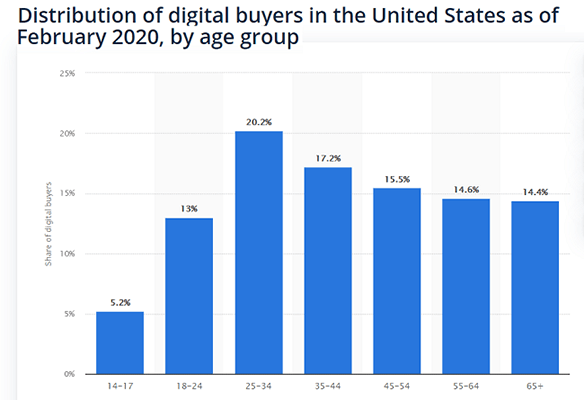
Source: Statista11
Ecommerce growth statistics
Over the past few years, the ecommerce industry has seen extreme growth. Here are some ecommerce statistics that shed some light on the rise of ecommerce.
25. Ecommerce sales grew by 27.6% in 2020
2020 was a breakthrough year for ecommerce. Although online shopping was already becoming more popular, the COVID-19 pandemic accelerated the growth of the industry, as more people took to their computers to shop to avoid going to stores and interacting with people.
This led to a huge surge in growth for the ecommerce industry. According to eMarketer the industry saw 27.6% growth based on the previous year.
Source: eMarketer
26. Singapore saw a 71.7% rise in ecommerce sales
In comparison to many countries globally, Singapore saw extremely high growth rates in the ecommerce industry.
According to eMarketer, Singaporean ecommerce sales increased by a whopping 71.7% in 2020. Another country that saw substantial growth was Argentina, which had around 79% more ecommerce transactions than in 2019. In fact, the whole Latin American region saw ecommerce sales grow by 36.7%.
Source: eMarketer
27. During the pandemic, the ecommerce share of grocery retail rose to 10%
One of the main ecommerce verticals that saw substantial growth as a result of the pandemic was groceries.
Groceries have traditionally been something you shop for in person, and whilst some stores had ecommerce options in place before the pandemic, many had to quickly adapt to meet the needs of their customers when countries went into lockdown. During the pandemic, online grocery purchases made up for 10% of the entire grocery industry.
Source: Statista9
28. And the ecommerce share of drug store retail rose to 16%
Another industry that was in high demand during the pandemic was the drug store industry. Despite restrictions, people still need access to their medications and other drug store products, which led to a rapid rise in the number of drug store orders that were made online.
At the height of the pandemic, 16% of all drug store transactions were being made online.
Source: Statista10
Ecommerce trends statistics
Want to keep your finger on the pulse of the latest developments in the world of ecommerce? Here are some facts and statistics relating to current and future ecommerce trends.
29. After switching to online shopping during the pandemic, 90% of shoppers intend to continue shopping online for the next 6 months
Although much of the rapid growth seen in the ecommerce industry last year as a result of the pandemic, many shoppers are keen to continue taking advantage of ecommerce stores.
According to Incisiv, around 90% of shoppers that switched to online shopping during 2020 intend to continue shopping online for 6 months or more. This is great news for businesses, as it seems that the increased popularity of online shopping will be an ongoing trend.
Source: Incisiv
30. 35% of people said they would shop online more regularly if they could virtually try on products
People are also keen to find more ways to make online shopping even more convenient. One of the major drawbacks of shopping online for apparel is that you can’t try products on like you can in a physical store.
However, 35% of people expressed that they would shop online more if they could virtually try on the product. This may lead to an increase in augmented reality technology that will allow people to try on products without leaving the house.
Source: 1Digital Agency
31. Experts predict that 72% of all ecommerce transactions will take place on mobile by the end of 2021
As more people are getting used to shopping online, many people are choosing to shop on mobile devices, rather than desktop ones. By the end of the year, it’s expected that almost 3/4 of ecommerce transactions will be made on mobile devices. This could lead to a rise in the number of mobile apps that make the online shopping experience more convenient for mobile users.
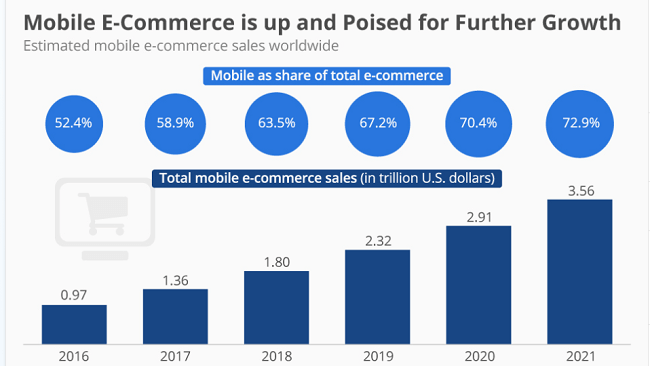
Source: Statista12
32. 75% of online shoppers want to receive less packaging with their goods
According to statistics published by Nosto, the average online shopper is becoming more eco-conscious, and sustainability is now a hot topic for ecommerce businesses.
Reportedly, 75% of shoppers would prefer to receive less packaging with their products. In the coming years, we can expect to see a rise in the number of ecommerce stores using reduced or sustainable packaging.
Source: Nosto
33. 75% of families will own a smart speaker by 2025
Smart speakers are becoming a part of everyday life. By 2024, 3/4 of homes in the US will have a smart speaker. Therefore, many ecommerce stores are keen to innovate to facilitate voice searches.
With smart speakers like Amazon Alexa, you can make purchases quickly and easily using only your voice, and this type of technology is likely to become more commonplace over the next few years.
Source: Statista13
Comments
Post a Comment